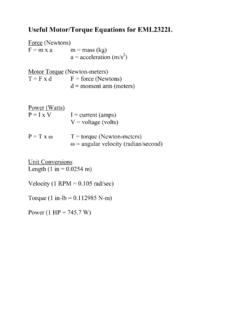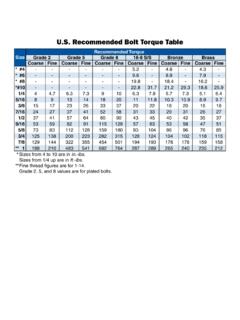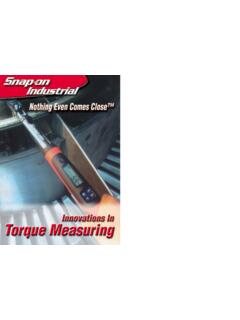Transcription of AP Physics 1- Torque, Rotational Inertia, and Angular ...
1 AP Physics 1- torque , Rotational Inertia, and Angular Momentum Practice Problems ANSWER KEY FACT: The center of mass of a system of objects obeys Newton s second law- F = Macm. Usually the location of the center of mass (cm) is obvious, but for several objects is expressed as: Mxcm = m1x1 + m2x2 + m3x3, where M is the sum of the masses in the expression. In some cases the center of mass is not located on the body of the object. When an object or system rotates, it will usually rotate around its center of mass. Expect 1-2 questions covering this topic on the AP Exam. Q1. A 59-kg woman and a 71-kg man sit on a seesaw, m long. Where is their center of mass? ( m) Q2. A fisherman in a boat catches a great white shark with a harpoon. The shark struggles for a while and then becomes limp when at a distance of 300 m from the boat. The fisherman pulls the shark by the rope attached to the harpoon.
2 During this operation, the boat (initially at rest) moves 45 m in the direction of the shark. The mass of the boat is 5400 kg. What is the mass of the shark? Pretend that the water exerts no friction. (mshark = 953 kg) Q3. A 70-kg man is standing on the end of a 250-kg log that is floating in the water. Both the man and the log are at rest, and the log is m long. If the man walks to the other end of the log, how far will the log move in the water? Ignore any forces exerted on the log by the water. (x = m or 66 cm to the right) FACT: torque ( ) is a force that causes an object to turn or rotate. It is a measure of a force s ability to cause an object to accelerate rotationally. If an object is initially at rest, and then starts to spin, something must have exerted a net torque . If an object is initially spinning, it would require a net torque to stop spinning.
3 FACT: We use sine for torque problems because the torque is a perpendicular force causing an Angular acceleration. By definition, the cross product of the force and the moment arm (lever arm, line of action) is the torque . The units for torque are , which is not referred to as a Joule. Notice that sine (90) = 1. Recall we used cosine in work problems because the force applied resulting in work is directly correlated with the displacement of the object. In this case, cosine (180) =1. Please study the diagrams below and note that = Fr sin = r F = rF sin = F r. The lever arm is the perpendicular distance from the axis of rotation to the point where the force is applied. You can also think of torque as the component of the force perpendicular to the lever arm multiplied by the distance (r). Q4: A captain of a ship turns the stirring wheel by applying a 20 N toque.
4 If he applies the force at a radius of m from the axis of rotation, at an angle of 80 degrees to the line of action (moment arm), what torque does he apply? ( ) Q5: A mechanic tightens the lugs on a tire by applying a torque of 110 Nm at an angle of 90 degrees to the moment arm. What force is applied if the wrench is m long? What is the minimum length if the wrench if the mechanic is only capable of applying a force of 200N? (275 N ; m) Q6. A constant force F is applied for five seconds at various points of the object, as shown in the diagram. Rank the magnitude of the torque exerted by the force on the object about an axle located at the center of mass from smallest to largest. (B,C,A,D) Q7. A student pulls down on a small modified Atwood machine with a force of 30 N, as shown in the diagram. What is the torque of this force?
5 ( ) FACT: An object will not rotate if the net torque ( ) is equal to zero. This is known as Rotational equilibrium. Q8. A 15-kg box sits on a lever arm at a distance of 5 meters from the axis of rotation. What distance must a second 10-kg box sit to create a clockwise moment that will result in a net torque of zero? What would occur if the moment arm of the second box was 8 m? ( m; torque = -50 ) Q9. Forces are applied along various points on a lever arm as shown below. Calculate the net torque and describe the resulting motion of the lever. Determine the force and distance from the axis of rotation that would result in a net moment ( torque ) of zero. The total negative (clockwise torque ) is 375 The counterclockwise positive torque is 195 The lever would rotate clockwise. Therefore, we need to apply a positive toque of 180 and this can be accomplished many different ways ( , 36 N at 5m counterclockwise to right of axis or 10 N at 18m counterclockwise to the left of the axis, etc.)
6 FACT: In torque problems with a large extended object (table, bridge, pole, ladder) do not forget that the lever arm itself will have a mass and a center of mass (cm). It is acceptable to assume the object s weight is all hanging from the cm. 15 kg Q10. A 3-kg Academy sign is hung from a 1-kg, 4-meter horizontal pole as shown. The sign is hung 1-meter from the right side. A wire is attached to prevent the sign from rotating. Find the tension in the wire. (Ft = 55 N) FACT: In table/bridge problems the fulcrum (pivot point) is arbitrary because the object is not rotating. Choose one of the supports as the fulcrum, which means that point now has zero torque (r = 0). Q11. A table has an 18-kg object placed meters from the left table leg. The mass of the table top is 6-kg. What is the force exerted on each leg? What would occur if the left leg broke?
7 (Right = 78 N and left = 162 N; lever arm would rotate counter-clockwise (positive) direction) Q12: A 50-kg box is hung from a 5-meter long, 200-kg horizontal pole as shown above. A wire is attached to prevent the sign from rotating. The box and wire attach at the right end of the pole as shown below. Find the tension in the wire. (2940N/3000N) FACT: A system is in static equilibrium when the sum of the forces and the sum of the torque are zero. We will also explore the idea of static equilibrium in an AP Investigation for this unit. This concept can be applied in what I call a ladder problem and you will encounter one of these problems on the AP Exam. In ladder problems, it is easier to use the perpendicular distance (r ) to find the torque . You can still use the perpendicular component of force (F ). Q13. A 5 meter, 200N-long ladder rests against a wall.
8 The ladders center of mass is meters up the ladder. The coefficient of friction on the ground is How far along the ladder can a 75-kg person climb before it slips? The angle between the ladder and ground is 56 degrees. ( m) Q14: Examine the diagram of a bear on a pole. The string (T) can hold a total of 900 N. Can the bear reach the 80-N basket of food without the string breaking? The total distance out to the food is 6-m. (No, the bear falls; max= m) FACT: The Rotational equivalent of Newton s Second Law is expressed as, = I , where I is the Rotational inertia and is the Angular acceleration. The Rotational inertia is sometimes referred to as the moment of inertia. Recall from translational dynamics that the larger the force, the greater the acceleration. Also, recall that the larger the mass, the smaller the acceleration (inversely proportional).
9 This also holds true for Rotational dynamics ( = I ); the Rotational inertia is inversely related to the Angular acceleration. FACT: Objects that have most of their mass near their axis of radiation have a small Rotational inertia, while objects that have more mass farther from the axis of rotation have larger Rotational inertias. The AP exam will provide with the formula for Rotational inertias, as they are derived using calculus. Here are some of the common formulas: Q15. An object with uniform mass density is rotated about an axle, which may be in position A, B, C, or D. Rank the object s Rotational inertia from smallest to largest based on the axle position. (C,B,D,A) FACT: For a system of objects you will need to add the Rotational inertia of each object to find the Rotational inertia of a system. For point masses, this can be expressed mathematically as I = mr2.
10 Q16. Find the moment of inertia (I) of two 5-kg bowling balls joined by a meter long rod of negligible mass when rotated about the center of the rod. Compare this to the I of the object when rotated about one of the masses. The dot indicates the axis. ( kg m2; 5 kg m2) Q17. What is the Angular acceleration experienced by a uniform solid disc of mass 2-kg and radius m when a net torque of 10 is applied? Assume the disc spins about its center. (1000 rad/s2) Q18. Given the net torque of the system, find the Angular acceleration for the system of three particle masses. The radius from the axis of rotation is 12 m and the masses are equidistant. Assuming a constant acceleration, what would the Angular velocity be after 5 seconds? How many revolutions will be completed after 20 seconds with constant acceleration? ( = rad/s2; = rad/s; use = 0t + t2 and covert radians to revolutions= 220 rad = 35 rev) FACT: The parallel axis theorem is given as: Ipa = Icm + Md2.







